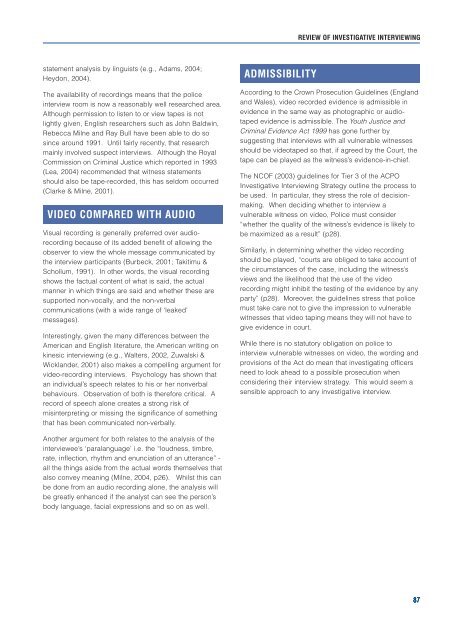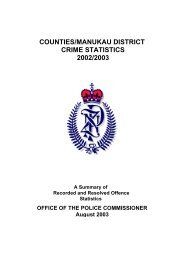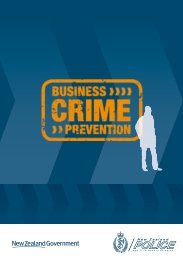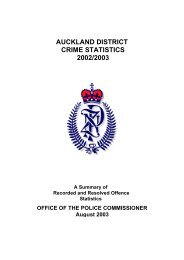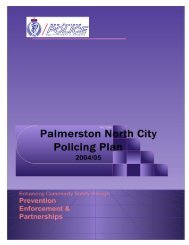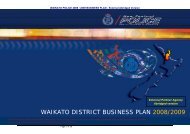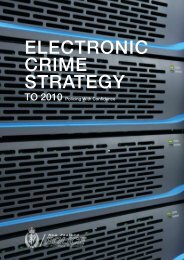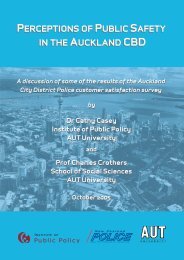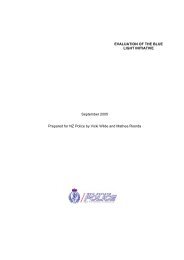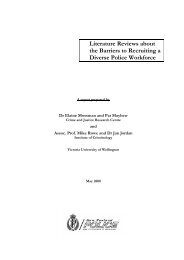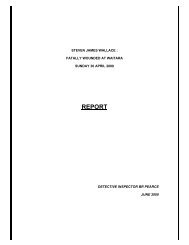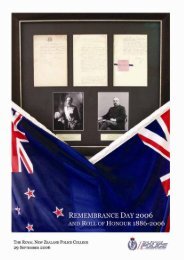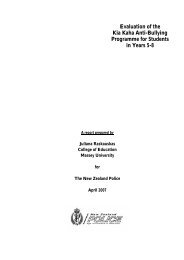Investigative interviewing: the literature - New Zealand Police
Investigative interviewing: the literature - New Zealand Police
Investigative interviewing: the literature - New Zealand Police
You also want an ePaper? Increase the reach of your titles
YUMPU automatically turns print PDFs into web optimized ePapers that Google loves.
REVIEW OF INVESTIGATIVE INTERVIEWING<br />
statement analysis by linguists (e.g., Adams, 2004;<br />
Heydon, 2004).<br />
The availability of recordings means that <strong>the</strong> police<br />
interview room is now a reasonably well researched area.<br />
Although permission to listen to or view tapes is not<br />
lightly given, English researchers such as John Baldwin,<br />
Rebecca Milne and Ray Bull have been able to do so<br />
since around 1991. Until fairly recently, that research<br />
mainly involved suspect interviews. Although <strong>the</strong> Royal<br />
Commission on Criminal Justice which reported in 1993<br />
(Lea, 2004) recommended that witness statements<br />
should also be tape-recorded, this has seldom occurred<br />
(Clarke & Milne, 2001).<br />
VIDEO COMPARED WITH AUDIO<br />
Visual recording is generally preferred over audiorecording<br />
because of its added benefit of allowing <strong>the</strong><br />
observer to view <strong>the</strong> whole message communicated by<br />
<strong>the</strong> interview participants (Burbeck, 2001; Takitimu &<br />
Schollum, 1991). In o<strong>the</strong>r words, <strong>the</strong> visual recording<br />
shows <strong>the</strong> factual content of what is said, <strong>the</strong> actual<br />
manner in which things are said and whe<strong>the</strong>r <strong>the</strong>se are<br />
supported non-vocally, and <strong>the</strong> non-verbal<br />
communications (with a wide range of ‘leaked’<br />
messages).<br />
Interestingly, given <strong>the</strong> many differences between <strong>the</strong><br />
American and English <strong>literature</strong>, <strong>the</strong> American writing on<br />
kinesic <strong>interviewing</strong> (e.g., Walters, 2002, Zuwalski &<br />
Wicklander, 2001) also makes a compelling argument for<br />
video-recording interviews. Psychology has shown that<br />
an individual’s speech relates to his or her nonverbal<br />
behaviours. Observation of both is <strong>the</strong>refore critical. A<br />
record of speech alone creates a strong risk of<br />
misinterpreting or missing <strong>the</strong> significance of something<br />
that has been communicated non-verbally.<br />
ADMISSIBILITY<br />
According to <strong>the</strong> Crown Prosecution Guidelines (England<br />
and Wales), video recorded evidence is admissible in<br />
evidence in <strong>the</strong> same way as photographic or audiotaped<br />
evidence is admissible. The Youth Justice and<br />
Criminal Evidence Act 1999 has gone fur<strong>the</strong>r by<br />
suggesting that interviews with all vulnerable witnesses<br />
should be videotaped so that, if agreed by <strong>the</strong> Court, <strong>the</strong><br />
tape can be played as <strong>the</strong> witness’s evidence-in-chief.<br />
The NCOF (2003) guidelines for Tier 3 of <strong>the</strong> ACPO<br />
<strong>Investigative</strong> Interviewing Strategy outline <strong>the</strong> process to<br />
be used. In particular, <strong>the</strong>y stress <strong>the</strong> role of decisionmaking.<br />
When deciding whe<strong>the</strong>r to interview a<br />
vulnerable witness on video, <strong>Police</strong> must consider<br />
“whe<strong>the</strong>r <strong>the</strong> quality of <strong>the</strong> witness’s evidence is likely to<br />
be maximized as a result” (p28).<br />
Similarly, in determining whe<strong>the</strong>r <strong>the</strong> video recording<br />
should be played, “courts are obliged to take account of<br />
<strong>the</strong> circumstances of <strong>the</strong> case, including <strong>the</strong> witness’s<br />
views and <strong>the</strong> likelihood that <strong>the</strong> use of <strong>the</strong> video<br />
recording might inhibit <strong>the</strong> testing of <strong>the</strong> evidence by any<br />
party” (p28). Moreover, <strong>the</strong> guidelines stress that police<br />
must take care not to give <strong>the</strong> impression to vulnerable<br />
witnesses that video taping means <strong>the</strong>y will not have to<br />
give evidence in court.<br />
While <strong>the</strong>re is no statutory obligation on police to<br />
interview vulnerable witnesses on video, <strong>the</strong> wording and<br />
provisions of <strong>the</strong> Act do mean that investigating officers<br />
need to look ahead to a possible prosecution when<br />
considering <strong>the</strong>ir interview strategy. This would seem a<br />
sensible approach to any investigative interview.<br />
Ano<strong>the</strong>r argument for both relates to <strong>the</strong> analysis of <strong>the</strong><br />
interviewee’s ‘paralanguage’ i.e. <strong>the</strong> “loudness, timbre,<br />
rate, inflection, rhythm and enunciation of an utterance” -<br />
all <strong>the</strong> things aside from <strong>the</strong> actual words <strong>the</strong>mselves that<br />
also convey meaning (Milne, 2004, p26). Whilst this can<br />
be done from an audio recording alone, <strong>the</strong> analysis will<br />
be greatly enhanced if <strong>the</strong> analyst can see <strong>the</strong> person’s<br />
body language, facial expressions and so on as well.<br />
87


